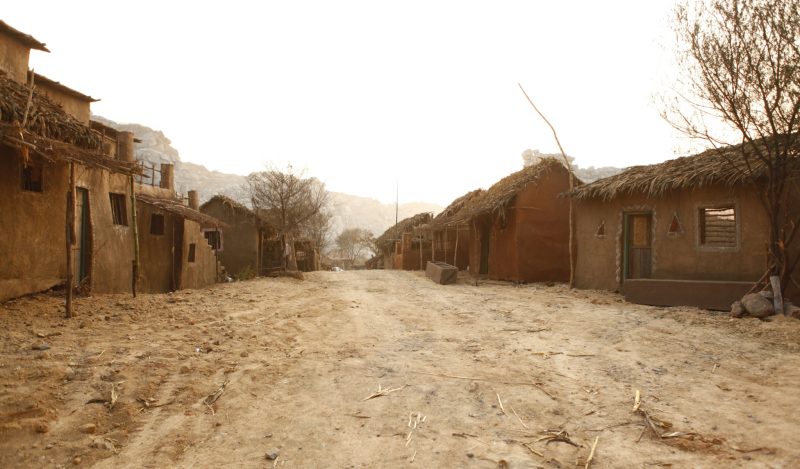Covid-19 accounted for under 0.3 percent of all deaths in Japan in 2020, well below the rates in Europe and the Americas that were the worst affected. More Japanese died from 25 other causes in 2020 (Figure 1), with seven times as many suicides, for example. Japan was also one of the few countries without excess mortality in the first year of the pandemic.
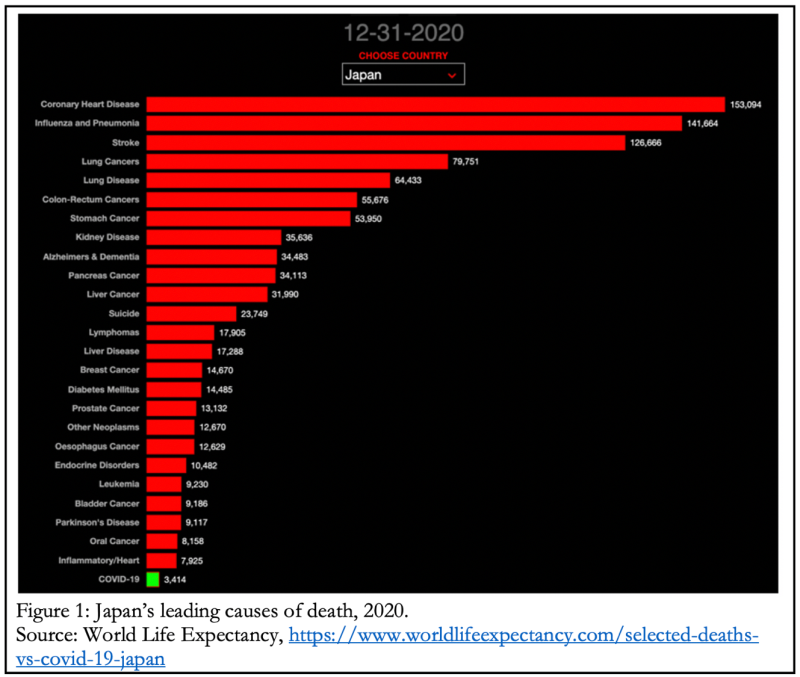
Japan attracted world attention for neither imposing a lockdown nor testing the asymptomatic obsessively. The Stringency Index from Oxford University’s Blavatnik School gauges the strictness of several lockdown measures including school and workplace closures, and travel bans, with 100 being the strictest. Japan’s index stayed below 50 until 8 December 2020, whereas all its G7 partners mostly stayed above 50.
This created a pandemic of fear about the threat of Covid. When the Diamond Princess docked in Yokohama in early 2020 with 712 infected passengers in a total of 3,711 people on board, of whom 14 died, Kentaro Iwata of Kobe University described the cruise ship as a “Covid-19 mill.” The mainstream media was on a mission to cheerlead the lockdown narrative and countries like Sweden and Japan were the focus of attacks to discredit their departure from the approved narrative. Much of the Western media was harshly critical and predicted mass deaths that would ravage Japan.
An article in The Washington Post on 20 February said Japan’s response was “completely inadequate.” On 10 April, William Pesek said “Japan’s coronavirus response is too little, too late” and advised Prime Minister Abe Shinzo to “dispense with the pandemic kabuki and call for a strict shelter-in-place policy.” Science magazine asked on 22 April if Japan had missed “its chance to keep the coronavirus in check.”
On 25 May The Washington Post reported Japan had ended its “soft lockdown” as part of an “idiosyncratic” policy of living with the virus. On 11 August, Pesek warned that Japan was “sitting on a ticking time bomb.” Australia’s national broadcaster the ABC, second to none in broadcasting pandemic fear porn, explained “How Shinzo Abe has fumbled Japan’s coronavirus response.” Medical experts began spouting scare scenarios once again with the second wave in winter 2020/21.
From the start there was little empirical data to support the efficacy of lockdowns. The virus was not unprecedented, but the draconian societal shutdowns, which overturned the existing scientific and policy consensus, were. Few would have believed a year earlier in March 2019 that Western democracies would so enthusiastically mimic China’s authoritarian behaviour and be cheered on by citizens for doing so.
Yet, European countries and US states with hard lockdowns fared no better than softer counterparts. After a year of this extreme experiment, data from around the world showed that the spread of the pandemic correlated more with geography, demography, and seasonality than lockdown stringency and sequencing. This Politico headline from 23 December 2020 would have been funny if it wasn’t tragic: “Locked-down California runs out of reasons for surprising surge.”

In 2020 Europe accounted for three times as many Covid deaths as its share of world population, North America six times, and South America 2.3 times (Table 1). By contrast Oceania had only one-twelfth, Africa one-fifth, and Asia one-third their respective shares of world population.
What might explain the variation by continents? In Africa and most of Asia outside East Asia, average life expectancy is much lower. Covid-19 is highly age-stratified, attacking those over 75 with particular ferocity.
Part of the reason for life being nasty, brutish, and short in the developing countries is that, proportionately, far more people with serious ailments succumb earlier owing to healthcare shortcomings than in the industrialised high-income countries, and Covid is far deadlier for people with comorbidities.
Third, in countries like India, universal BCG and polio vaccination is mandatory, while the immune systems of people have a lifelong exposure to curative and preventive drugs for malaria. Research by Indian scientists suggested that exposure since childhood to an extensive range of pathogens has given Indians sturdier immunity to Covid-19. Another study suggested a similar conclusion holds for sub-Saharan Africa.
Real-world examples of non-lockdown countries with similar or better outcomes as lockdown countries, but without the accompanying massive health, mental health, livelihood, economic, and civil liberties harms, should have been welcome. Instead, many commentators seemed secretly wanting the soft and no-lockdown countries to fail.
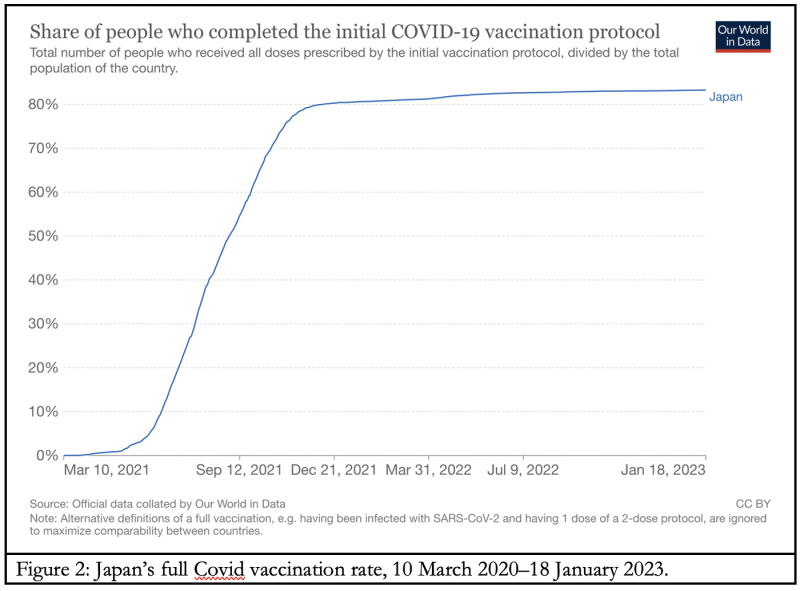
When the predicted catastrophism failed to materialise, the media pivoted to explaining Japan’s (and East Asia’s more broadly) success in escaping the worst of Covid to the culture of wearing masks. Japan is a highly conformist society with extraordinarily high levels of public compliance with government directives. Mask-wearing is all-pervasive, both for source control when people are ill with the cold and flu (and less commonly to prevent infection of oneself), and as a visible mark of consideration to the community.
On 22 June 2020, an article in Forbes by Joel Rush described the secret to Japan’s success in beating the virus was the over 90 percent masking by the people: “predominant mask use has played a critical role in suppressing the spread of the coronavirus in Japan.”
On 19 October 2020, Julian Ryall wrote for Deutsche Welle that while others had protested against masks as “unnecessary, ineffective” and “an infringement of civil liberties,” Japan’s mask tradition had helped to save lives. On 18 June 2022, Kanoko Matsuyama and James Mayger argued in Bloomberg that “continued mask wearing” and “extensive vaccination” were among “the core factors” behind Japan’s Covid death rate being the lowest “among the wealthiest nations.”
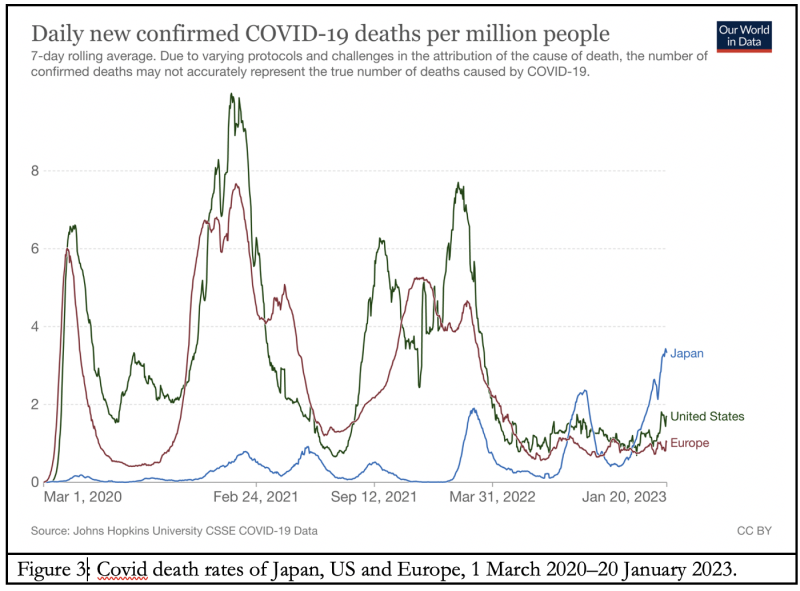
Looking at Figure 3, we can see the reason for the encomia until mid-2022. Unfortunately, however, that served to provoke the Covid gods into action. Japan’s rolling 7-day average of daily new deaths per million people exceeded that of the US and the European average on 11 August, dipped below them on 3 October for a brief period, but once again rose above theirs on 26 November and has stayed stubbornly higher since then. On 18 January Japan’s rate of 3.43 deaths per million people was more than twice that of the US (1.44) and four times that of Europe (0.82).
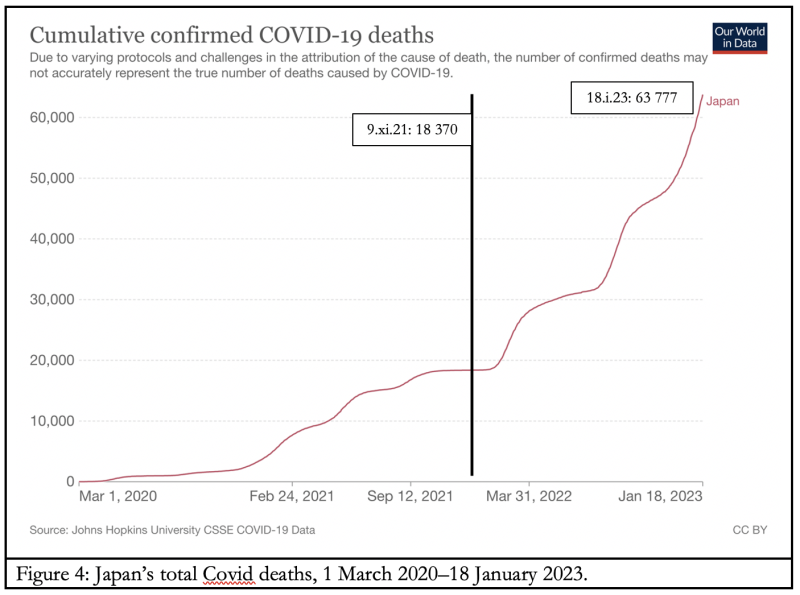
This is so despite both ubiquitous masking and very high vaccine takeup (Figure 2).
Japan hit 80 percent full vaccination (which translates into over 90 percent vaccination of adults) on 9 December 2021 when its Covid daily death rate was 0.01 per million. This had risen to 3.43 per million on 9 January 2023. Total deaths had increased from 18,370 to 63,777 over that period (Figure 4).
Thus 2.5 times as many people died with Covid in the 13.5 months after than in the 21.3 months before 80 percent full vaccination. Yet they still refuse to entertain the notion that vaccines might be the problem, not the solution.
The continued hold of the “safe and effective” vaccine mantra and facemasks efficacy for controlling the coronavirus is cause for despair in official cussedness and public gullibility. The transient effectiveness of vaccines has necessitated boosters every few months. Often vaccine rollouts coincided with upsurge in infections and deaths, suggesting negative efficacy. Newer studies show successor doses are less effective and repeated doses may be driving infections by damaging the immune function.
Many warned from the start that like all coronaviruses, SARS-CoV-2 also would likely follow its own trajectory—virus gonna virus and all that—and prove policy-invariant. There’s nothing to suggest this common understanding was and is wrong. The sooner governments give up on their fatal conceit that they can control the virus, the sooner we can return to pre-Covid normalcy.
Perhaps in recognition of this harsh reality, there is speculation that Japan may be preparing to downgrade the status of Covid-19. It is currently listed at the most serious threat level but could be shifted down to number 5 after reclassification. This would help to lift remaining restrictions.
The ineffectiveness of Covid vaccines is by now widely acknowledged and known. Regarding the “safe” half of the mantra, growing doubts over the age-segregated net harms-benefits ratio have also begun to break through the wall of official censorship and media apathy.
People give more credence to their “lived experience” and by now most know, or know of, many persons who have been infected, some seriously, despite multiple jabs. Visuals of fit and young athletes collapsing suddenly don’t help either, especially when it’s got to the point of being openly mocked by popular TV host Mark Steyn discussing “Cause Unknown” as Alberta’s leading cause of death, and sites like the satirical Babylon Bee:
Experts Say They Don’t Know What Thing Is Causing Everyone To Suddenly Collapse, But It’s Definitely Not That One Thing.

In 2020 the media flipped from exposing official lies to amplifying them instead. On 21 January The Australian became the first major MSM outlet in the country to publish a feature story on the hidden toll of vaccine injuries. Most of the upvoted comments on the story said welcome to this side of the tracks, but what took you so long? Calls have grown for an immediate suspension of vaccinations until the unusually strong correlations with excess deaths, heart problems and female reproduction are properly investigated.
Of more relevance to Japan, on 25 November the distinguished oncologist Masanori Fukushima, emeritus professor at Kyoto University, excoriated the health bureaucrats’ secrecy and negligence for ignoring their solemn responsibility to protect the public from harmful vaccines. The video, with English subtitles, has been widely viewed and circulated in Japan and around the world, not the least because he pulled no punches.
On 12 January, Japan’s Ministry of Health approved lump-sum compensation payments for five people who died after Covid vaccinations. The ministry concluded that a causal link between the deaths and vaccines cannot be ruled out. In a matching vein, suspicions become only stronger in the West that regulators have become vaccine enablers first, more committed to defend vaccines from criticism than protect people from harmful vaccines. Dr. Richard Ennos, a retired biology professor from Edinburgh University, concludes that:
Glaring safety signals are apparent indicating harm to the lymph system, the heart and to female reproduction. There can be no question that the mRNA vaccines should be withdrawn with immediate effect.
Perhaps it is time to introduce the neologism “iatrocide” to the English language. Meanwhile some other countries have taken note of the severity of the current wave of infections and mortality levels in Japan and introduced checks on incoming travellers from there, as well as from China.
While this is understandable although still questionable as a long-term Covid management strategy, one aspect that is back is the list of the bizarre and the idiotic requirements. People from Australia going to India are not required to produce proof of a negative PCR test, for Australia is not presently a high risk country.
But Australian travellers (or Americans from the West Coast) transiting through Singapore, because it is a hub for travellers from China and Japan, must be tested in the 72 hours before the commencement of their journey.
Just think about that for a moment. The fear is that an incoming traveller could be infected while transiting through Singapore, not while in Australia. But the PCR test must be organised and conducted in Australia in the three days before the person transits Singapore. The PCR test must have more sophisticated diagnostic capabilities than I had realised, to be able to anticipate an infection up to 80 hours before catching it from a fleetingly passing stranger in the airport terminal in Singapore.
Magical!
Published under a Creative Commons Attribution 4.0 International License
For reprints, please set the canonical link back to the original Brownstone Institute Article and Author.







